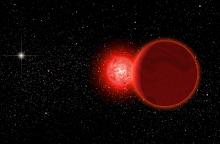Listen to today's episode of StarDate on the web the same day it airs in high-quality streaming audio without any extra ads or announcements. Choose a $8 one-month pass, or listen every day for a year for just $30.
You are here
Mars and Company
The solar system offers up some amazing treats tonight. First, there’s a conjunction between the Moon and the planet Saturn. And second, the planet Mars is just about at its closest to Earth for the entire year, so it looks like a brilliant orange star.
Saturn is the bright object just below the Moon as night falls. It’s the second-largest planet in the solar system, which is one reason it shines so brightly. Another is that its broad, bright rings are tilted into good view, so they reflect a lot of sunlight. But it’s about 800 million miles away -- a distance that dulls its luster a bit.
Mars, on the other hand, is less than 36 million miles away -- just about as close as it ever gets. So it shines much brighter than Saturn, even though it’s only about one-twentieth the diameter of Saturn.
Mars is not only closer to Earth, but it’s also closer to the Sun than Saturn is. As a result, sunlight at Mars is about 40 times more intense than it is at Saturn. That’s a lot more light for Mars to reflect back in our direction.
Mars looks orange because much of its surface is coated by a powdery orange dust. That dust contains a lot of iron oxide -- the compound that makes up the rust on your iron pipes. The fine dust grains blow across much of the planet, covering vast plains and filling basins and craters. And sometimes, it forms giant storms that can cover the entire planet.
We’ll have more about Mars tomorrow.





